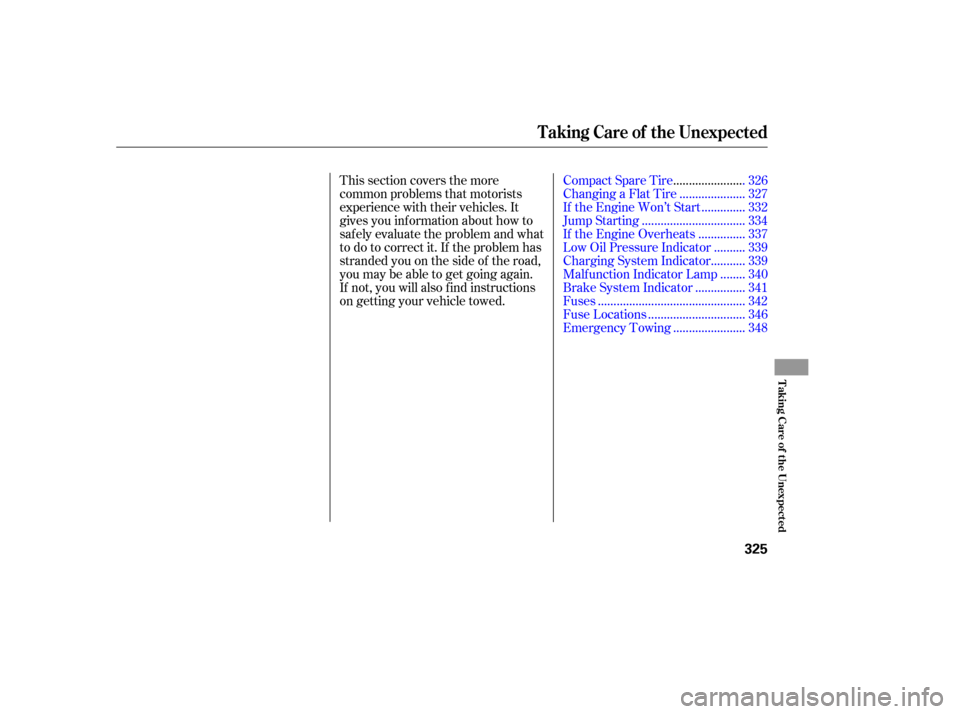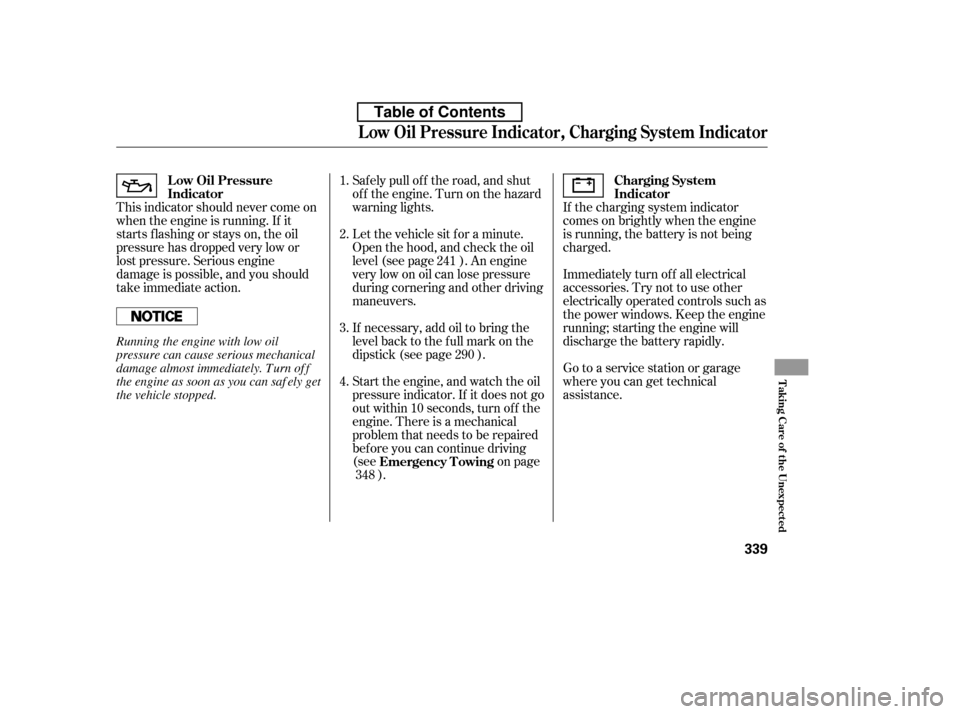Page 339 of 387

This section covers the more
common problems that motorists
experience with their vehicles. It
gives you inf ormation about how to
safely evaluate the problem and what
to do to correct it. If the problem has
stranded you on the side of the road,
you may be able to get going again.
If not, you will also f ind instructions
on getting your vehicle towed.......................Compact Spare Tire . 326
....................
Changing a Flat Tire . 327
.............
If the Engine Won’t Start . 332
................................
Jump Starting . 334
..............
If the Engine Overheats . 337
.........
Low Oil Pressure Indicator . 339
..........
Charging System Indicator . 339
.......
Malf unction Indicator Lamp . 340
...............
Brake System Indicator . 341
..............................................
Fuses . 342
..............................
Fuse Locations . 346
......................
Emergency Towing . 348
Taking Care of the Unexpected
T aking Care of t he Unexpect ed
325
Page 353 of 387

Let the vehicle sit f or a minute.
Open the hood, and check the oil
level (see page ). An engine
very low on oil can lose pressure
during cornering and other driving
maneuvers.
If necessary, add oil to bring the
level back to the full mark on the
dipstick (see page ).
Start the engine, and watch the oil
pressure indicator. If it does not go
out within 10 seconds, turn of f the
engine. There is a mechanical
problem that needs to be repaired
bef ore you can continue driving
(see on page).
Saf ely pull of f the road, and shut
of f the engine. Turn on the hazard
warning lights.
This indicator should never come on
when the engine is running. If it
starts flashing or stays on, the oil
pressure has dropped very low or
lost pressure. Serious engine
damage is possible, and you should
take immediate action. If the charging system indicator
comes on brightly when the engine
is running, the battery is not being
charged.
Immediately turn of f all electrical
accessories. Try not to use other
electrically operated controls such as
the power windows. Keep the engine
running; starting the engine will
discharge the battery rapidly.
Go to a service station or garage
where you can get technical
assistance.
1. 2. 3. 4.
241
290
348 Emergency T owing
L ow Oil Pressure
Indicator
Charging System
Indicator
L ow Oil Pressure Indicator, Charging System Indicator
T aking Care of t he Unexpect ed
339
Running the engine with low oil
pressure can cause serious mechanical
damage almost immediately. Turn of f
the engine as soon as you can saf ely get
the vehicle stopped.
Table of Contents
Page 368 of 387

�µ�µ
�µ �µ�µ �µ �µ�µ�µ�µ�µ�µ�µ�µ�µ�µ
�Î �Î �Î�Î�Î�Î�Î �Î�Î�Î�Î�Î
�Î�Î�Î�Î�Î�Î�Î�Î�Î�Î
�Î
�Î
�Î �Î
Specif ications
T echnical Inf ormation
355
Air Conditioning
Capacities
Lights
Refrigerant type
Charge quantity
Lubricant oil type
HFC-134a (R-134a)
14.1 15.9 oz (400 450 g) SP-10
12 V 60 W (HB3) 12 V 51 W (HB4)
12 V 24/2 CP
12 V 21 W
12 V 21/5 W
12 V 2 CP
12 V 21 W
12 V 3 CP
12 V 21 W
4.8 US qt (4.5
)
1.8 US qt (1.7
)
1.6 US qt (1.5
)
1.19 US gal (4.5
)
1.80 US gal (6.8
)
4.6 US qt (4.4
)
4.4 US qt (4.2
)
5.8 US qt (5.5
)
6.08 US qt (5.75
)
2.5 US qt (2.4)
1.40 US gal (5.3
)
1.77 US gal (6.7
)
2.6 US qt (2.5
)
1.7 US qt (1.6
)
1.5 US qt (1.4
)
1.37 US gal (5.2
)
1.72 US gal (6.5
)
3.9 US qt (3.7
)
3.7 US qt (3.5
)
4.8 US qt (4.5
)
13.2 US gal (50
)
Fuel tank
Engine
coolant
Engine oil Manual
transmission
fluid Automatic
transmission
fluid
Windshield
washer
reservoir Headlights
Front turn signal/side marker/
Parking lights
Rear turn signal lights
Stop/Taillights
Rear side marker lights
Back-up lights
Taillights
High-mount brake light
Fog lights
License plate lights
Ceiling light
Spotlights
Trunk light 12 V
12 V
12 V
12 V
5W
8W
8W
5W
12 V 55 W
Including the coolant in the reserve tank and that remaining in the
engine
Reserve tank capacity: 0.11 US gal (0.4
)
Excluding the oil remaining in the engine High Low
A/T
M/T
A/T
M/T
Change Total
U.S. Vehicles
Canada
Vehicles Approx.
Except Si
Change
Including filter
Without filter
Total
ChangeTotal
Change Total (Amber)
(Amber)
(H11)
Si
Except DX, Canadian DX-G
1: 2: 3:4:5:
13
34334
3434343434
2
4
5 3
Table of Contents
Page 387 of 387

Service Inf ormat ion Summary
Automatic Transmission Fluid: Brake Fluid:
Gasoline:
Tire Pressure (measured cold):
Recommended Engine Oil:
Fuel Tank Capacity: Manual Transmission Fluid:
Power Steering Fluid:
Except Si Si
Except Si Si
Except Si Si
All models except Si and
Canadian DX-G (M/T) EX-L,U.S.LX,LX-S,EX,
Canadian Sport
DX, Canadian DX-G Si
Honda Heavy Duty Brake Fluid
DOT 3 preferred, or a DOT 3 or
DOT 4 brake fluid as a temporary
replacement (see page ).
Front/Rear:
30 psi (210 kPa , 2.1 kgf/cm
)
Unleaded gasoline, pump octane
number of 87 or higher.
4.6 US qt (4.4
)
Oil change capacity (including
filter):
API Premium grade 5W-30
detergent oil (see page ). 3.9 US qt (3.7
)
Oil change capacity (including
filter):
API Premium grade 5W-20
detergent oil (see page ).
13.2 US gal (50
)
Honda Manual Transmission
Fluid preferred, or an SAE 10W-30
or 10W-40 motor oil as a
temporary replacement (see page
).
Capacity (including differential):
1.5 US qt (1.4
)
1.6 US qt (1.5
)
Honda Power Steering Fluid
preferred, or another brand of
power steering fluid as a
temporary replacement. Do not
use ATF (see page ).
Honda Genuine ATF-Z1
(automatic transmission fluid)
(see page ).
60 psi (420 kPa , 4.2 kgf/cm
)
Spare Tire: 33 psi (230 kPa , 2.3 kgf/cm
)
32 psi (220 kPa , 2.2 kgf/cm
)
Premium unleaded gasoline,
pump octane number of 91 or
higher recommended (see ‘‘Fuel
Recommendations’’ on page ).
238
291
291 298
299
301 300